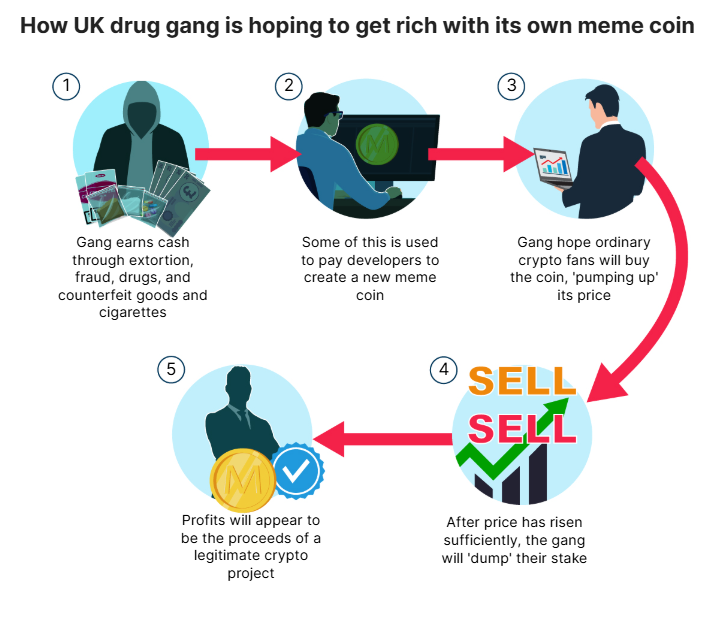| COINOTAG recommends • Exchange signup |
| 💹 Trade with pro tools |
| Fast execution, robust charts, clean risk controls. |
| 👉 Open account → |
| COINOTAG recommends • Exchange signup |
| 🚀 Smooth orders, clear control |
| Advanced order types and market depth in one view. |
| 👉 Create account → |
| COINOTAG recommends • Exchange signup |
| 📈 Clarity in volatile markets |
| Plan entries & exits, manage positions with discipline. |
| 👉 Sign up → |
| COINOTAG recommends • Exchange signup |
| ⚡ Speed, depth, reliability |
| Execute confidently when timing matters. |
| 👉 Open account → |
| COINOTAG recommends • Exchange signup |
| 🧭 A focused workflow for traders |
| Alerts, watchlists, and a repeatable process. |
| 👉 Get started → |
| COINOTAG recommends • Exchange signup |
| ✅ Data‑driven decisions |
| Focus on process—not noise. |
| 👉 Sign up → |
-
A UK drug gang has innovatively ventured into cryptocurrency by launching a meme coin, marking a significant evolution in crypto-related crime.
-
This unprecedented move highlights a broader trend, as experts reveal that meme coins are increasingly being used as tools for money laundering, complicating regulatory efforts.
-
Gary Carroll of Claymore Advisory Group underscores, “This method allows gangs to legitimize criminal earnings by riding the speculative wave of meme culture.”
UK gang’s launch of a meme coin represents a new wave in crypto crime, demonstrating how easily illicit profits can be laundered through digital tokens.
Meme Coins and Money Laundering – A New Trend for Criminals?
This new tactic underscores the rapid adaptation of criminal enterprises to utilize cryptocurrency as a means of laundering money. Historically, gangs have relied on traditional methods, but with the advent of cryptocurrencies, particularly meme coins, they can now leverage social media hype to manipulate market dynamics.
The gang in question has diversified its operations beyond traditional crime, integrating digital asset fundraising into their revenue streams. While the specifics of the coin’s name and the gang’s identity remain undisclosed, the transition to creating a meme coin signifies a shift in their laundering methods.
Gary Carroll elaborates on this trend: “The rapid fluctuations in meme coin values present opportunities for illicit actors to employ legitimate facades, masking their illegal activities under the guise of cryptocurrency trading.”
| COINOTAG recommends • Professional traders group |
| 💎 Join a professional trading community |
| Work with senior traders, research‑backed setups, and risk‑first frameworks. |
| 👉 Join the group → |
| COINOTAG recommends • Professional traders group |
| 📊 Transparent performance, real process |
| Spot strategies with documented months of triple‑digit runs during strong trends; futures plans use defined R:R and sizing. |
| 👉 Get access → |
| COINOTAG recommends • Professional traders group |
| 🧭 Research → Plan → Execute |
| Daily levels, watchlists, and post‑trade reviews to build consistency. |
| 👉 Join now → |
| COINOTAG recommends • Professional traders group |
| 🛡️ Risk comes first |
| Sizing methods, invalidation rules, and R‑multiples baked into every plan. |
| 👉 Start today → |
| COINOTAG recommends • Professional traders group |
| 🧠 Learn the “why” behind each trade |
| Live breakdowns, playbooks, and framework‑first education. |
| 👉 Join the group → |
| COINOTAG recommends • Professional traders group |
| 🚀 Insider • APEX • INNER CIRCLE |
| Choose the depth you need—tools, coaching, and member rooms. |
| 👉 Explore tiers → |

Illustration of How Criminals Launder Money Using Meme Coins. Source: MailOnline
| COINOTAG recommends • Exchange signup |
| 📈 Clear interface, precise orders |
| Sharp entries & exits with actionable alerts. |
| 👉 Create free account → |
| COINOTAG recommends • Exchange signup |
| 🧠 Smarter tools. Better decisions. |
| Depth analytics and risk features in one view. |
| 👉 Sign up → |
| COINOTAG recommends • Exchange signup |
| 🎯 Take control of entries & exits |
| Set alerts, define stops, execute consistently. |
| 👉 Open account → |
| COINOTAG recommends • Exchange signup |
| 🛠️ From idea to execution |
| Turn setups into plans with practical order types. |
| 👉 Join now → |
| COINOTAG recommends • Exchange signup |
| 📋 Trade your plan |
| Watchlists and routing that support focus. |
| 👉 Get started → |
| COINOTAG recommends • Exchange signup |
| 📊 Precision without the noise |
| Data‑first workflows for active traders. |
| 👉 Sign up → |
Through strategic online marketing, the gang hopes to inflate the coin’s price dramatically. Carroll points out that even a minor price increase can yield substantial profits before liquidating their holdings, allowing them to present these earnings as gains from lawful crypto business activities rather than narcotics.
Are Launchpads Amplifying Crypto Crime?
The emergence of launchpads has made it alarmingly easy for new projects to gain traction, including those with malicious intent. Experts warn that the reduced barriers to entry are likely to entice criminal organizations looking to exploit meme coins as a laundering mechanism.
| COINOTAG recommends • Traders club |
| ⚡ Futures with discipline |
| Defined R:R, pre‑set invalidation, execution checklists. |
| 👉 Join the club → |
| COINOTAG recommends • Traders club |
| 🎯 Spot strategies that compound |
| Momentum & accumulation frameworks managed with clear risk. |
| 👉 Get access → |
| COINOTAG recommends • Traders club |
| 🏛️ APEX tier for serious traders |
| Deep dives, analyst Q&A, and accountability sprints. |
| 👉 Explore APEX → |
| COINOTAG recommends • Traders club |
| 📈 Real‑time market structure |
| Key levels, liquidity zones, and actionable context. |
| 👉 Join now → |
| COINOTAG recommends • Traders club |
| 🔔 Smart alerts, not noise |
| Context‑rich notifications tied to plans and risk—never hype. |
| 👉 Get access → |
| COINOTAG recommends • Traders club |
| 🤝 Peer review & coaching |
| Hands‑on feedback that sharpens execution and risk control. |
| 👉 Join the club → |
The toll of scams in the cryptocurrency space is staggering, with losses easily reaching billions. The rise of pump-and-dump schemes correlates directly with the influx of illicit actors leveraging these schemes to obscure the source of their funds.
“I predict that within the next one to two years, we will see legal ramifications arising from these activities in the UK,” Carroll forecasts confidently. “This can become a normalized method for criminals to semi-legitimize their operations,” he adds.
According to a report from Merkle Science published earlier this year, the prevalence of scams associated with meme coins resulted in over $500 million in losses globally in 2024 alone. A significant portion of these scams were executed via platforms like X (formerly Twitter) and YouTube, indicating where criminals find fertile ground for their schemes.
Notably, over 75% of meme coin scams occurred on X, with social engineering tactics being a prominent method. The influence of this methodology illustrates the contrasting development of digital assets from revolutionary technologies to tools for criminal activity.
| COINOTAG recommends • Exchange signup |
| 📈 Clear control for futures |
| Sizing, stops, and scenario planning tools. |
| 👉 Open futures account → |
| COINOTAG recommends • Exchange signup |
| 🧩 Structure your futures trades |
| Define entries & exits with advanced orders. |
| 👉 Sign up → |
| COINOTAG recommends • Exchange signup |
| 🛡️ Control volatility |
| Automate alerts and manage positions with discipline. |
| 👉 Get started → |
| COINOTAG recommends • Exchange signup |
| ⚙️ Execution you can rely on |
| Fast routing and meaningful depth insights. |
| 👉 Create account → |
| COINOTAG recommends • Exchange signup |
| 📒 Plan. Execute. Review. |
| Frameworks for consistent decision‑making. |
| 👉 Join now → |
| COINOTAG recommends • Exchange signup |
| 🧩 Choose clarity over complexity |
| Actionable, pro‑grade tools—no fluff. |
| 👉 Open account → |
Merkle Science further notes that the Solana blockchain has been particularly attractive for criminals due to tools such as pump.fun, which simplify the process of launching and promoting meme coins while minimizing the complexity associated with traditional digital asset exchange mechanisms.
Conclusion
This pioneering use of meme coins by gangs in the UK not only showcases the evolving landscape of cryptocurrency-related crime but also highlights the urgent need for effective regulatory frameworks. As cryptocurrency adoption grows, so too does the potential for its misuse, emphasizing the importance of vigilance in both the regulatory and investment landscapes.
| COINOTAG recommends • Members‑only research |
| 📌 Curated setups, clearly explained |
| Entry, invalidation, targets, and R:R defined before execution. |
| 👉 Get access → |
| COINOTAG recommends • Members‑only research |
| 🧠 Data‑led decision making |
| Technical + flow + context synthesized into actionable plans. |
| 👉 Join now → |
| COINOTAG recommends • Members‑only research |
| 🧱 Consistency over hype |
| Repeatable rules, realistic expectations, and a calmer mindset. |
| 👉 Get access → |
| COINOTAG recommends • Members‑only research |
| 🕒 Patience is an edge |
| Wait for confirmation and manage risk with checklists. |
| 👉 Join now → |
| COINOTAG recommends • Members‑only research |
| 💼 Professional mentorship |
| Guidance from seasoned traders and structured feedback loops. |
| 👉 Get access → |
| COINOTAG recommends • Members‑only research |
| 🧮 Track • Review • Improve |
| Documented PnL tracking and post‑mortems to accelerate learning. |
| 👉 Join now → |
| COINOTAG recommends • Members‑only research |
| 📌 Curated setups, clearly explained |
| Entry, invalidation, targets, and R:R defined before execution. |
| 👉 Get access → |
| COINOTAG recommends • Members‑only research |
| 🧠 Data‑led decision making |
| Technical + flow + context synthesized into actionable plans. |
| 👉 Join now → |
| COINOTAG recommends • Members‑only research |
| 🧱 Consistency over hype |
| Repeatable rules, realistic expectations, and a calmer mindset. |
| 👉 Get access → |
| COINOTAG recommends • Members‑only research |
| 🕒 Patience is an edge |
| Wait for confirmation and manage risk with checklists. |
| 👉 Join now → |
| COINOTAG recommends • Members‑only research |
| 💼 Professional mentorship |
| Guidance from seasoned traders and structured feedback loops. |
| 👉 Get access → |
| COINOTAG recommends • Members‑only research |
| 🧮 Track • Review • Improve |
| Documented PnL tracking and post‑mortems to accelerate learning. |
| 👉 Join now → |







